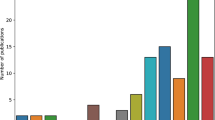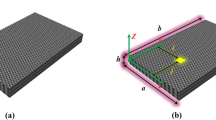The inverse problem on determining the location of a delamination and its severity in composite uniform beams is considered. It is shown that the problem can be solved in terms of delamination-induced changes in the natural frequencies or mode shapes. Delaminations are quantified by the artificial neural networks or random forests. The machine learning methods can predict the delamination status based on parameters of the natural frequency or the Haar wavelet transform coefficients derived from the first mode shape. Simulation studies showed that the combined approach of natural frequencies, Haar wavelets, and random forests produced accurate predictions. The results presented in this article can help one to understand the behavior of more complex structures under similar conditions.








Similar content being viewed by others
References
R. A. Patil and M.V. Kavade, “Delamination detection in composite sandwich beam: experimental study,” Journal of Advances in Science and Technology, 13, No. 1, 199-204 (2017).
Z. Yang, L. Wang, H. Wang, et al., “Damage detection in composite structures using vibration response under stochastic excitation,” Journal of Sound and Vibration, 325, No. 45, 755-768 (2009).
L. H. Yam, Y. J. Yan, and J. S. Jiang, “Vibration-based damage detection for composite structures using wavelet transform and neural network identification,” Composite Structures, 60, No. 4, 403-412 (2003).
A. Tuck and V. Kekoc, “KC–30A structural health monitoring system verification and validation; MRH 90 HUMS,” AIAC14 Fourteenth Australian International Aerospace Congress, 3-18 (2011).
R. L. Ramkumar, S.V. Kulkarni, and B. Pipes, “Free vibration frequencies of a delaminated beam”, 34th Annual Technical Conference Proceedings, 1-5 (1979).
J. T. S. Wang, Y. Liu, and J. A. Gibby, “Vibration of split beams”, Journal of Sound and Vibration, 84, 491-502 (1982).
P. Mujumdar and S. Suryanarayan, “Flexural vibration of beams with delaminations,” Journal of Sound and Vibration, 125, 441-461 (1988).
T. Nagashima and H. Suemasu, “X-FEM analyses of a thin-walled composite shell structure with a delamination,” Computers and Structures, 88, 549-557 (2010).
S. K. Kumar, R. Ganguli, and D. Harursampath, “Partial delamination modeling in composite beams using a finite element method,” Finite Elements in Analysis and Design, 76, 1-12 (2013).
C. Gowda, N. Rajanna, and N. G. S. Udupa, “Investigating the effects of delamination location and size on the vibration behaviour of laminated composite beams,” Materials Today, 4, 10944-10951 (2017).
D. Y. Yin, C. F. Zhu, X. C. Chen et al. “Finite-element analysis and an experimental study into the water jet reaming process of carbon-carbon composites,” Mech. Compos. Mater., 57, No. 2, 257-268 (2021).
A. Pupurs, M. Loukil, and J. Varna, “Bending stiffness of damaged cross-ply laminates,” Mech. Compos. Mater., 57, No. 1, 31-46 (2021).
A. Okafor, K. Chandrashekhara, and Y. P. Jiang, “Delamination prediction in composite beams with built-in piezoelectric devices using modal analysis and neural network,” Smart Materials and Structures, 5, 338 (1999).
D. Chakraborty, “Artificial neural network based delamination prediction in laminated composites,” Materials and Design, 26, 1-7 (2005).
P. Adams, “Damage detection in composite structures using piezoelectric materials (and neural net),” Smart Material Structures, 3, 318-328 (1994).
M. Krawczuk and W. Ostachowicz, “Identification of delamination in composite beams by genetic algorithm,” Science and Engineering of Composite Materials, 10, 147-155 (2002).
A. Nag, D. Mahapatra, and S. Gopalakrishnan, “Identification of delamination in composite beams using spectral estimation and a genetic algorithm,” Smart Materials and Structures, 11, 899 (2002).
Z.Z. Wang, J. Zhao, X. Ma et al., “Numerical simulation of progressive delamination in composite laminates under mode I and mode II loadings,” Mech. Compos. Mater., 56, No. 6, 735-746 (2021).
M. Rucka and K. Wilde, “Application of continuous wavelet transform in vibration based damage detection method for beams and plates,” Journal of Sound and Vibration, 297, No. 35, 536-550 (2006).
S. Zheng, Z. Li, and H. Wang, “Research on delamination monitoring for composite structures based on HHGAWNN,” Applied Soft Computing, 9, No. 3, 918-923 (2009).
C. Chui, Wavelets: a Mathematical Tool for Signal Analysis, Society for Industrial and Applied Mathematics, USA (1997).
C.K. Chen and C.H. Hsiao, “Haar wavelet method for solving lumped and distributed-parameter systems,” Control Theory and Applications, 144, No. 1, 87-94 (1997).
C.-H. Hsiao and W.-J. Wang, “State analysis of time-varying singular nonlinear systems via Haar wavelets,” Mathematics and Computers in Simulation, 51, No. 12, 91-100 (1999).
Ü. Lepik, “Numerical solution of differential equations using Haar wavelets,” Mathematics and Computers in Simulation, 68, No. 2, 127-143 (2005).
M. Ratas, A. Salupere, and J. Majak, “Solving nonlinear PDEs using the higher order Haar wavelet method on nonuniform and adaptive grids,” Mathematical Modelling and Analysis, 1, No. 26, 147-169 (2021).
M. Sorrenti, M. Di Sciuva, J. Majak, and F. Auriemma, “Static response and buckling loads of multilayered composite beams using the refined Zigzag theory and higher-order Haar wavelet method,” Mech. Compos. Mater., 57, No. 1, 1-18 (2021).
Z. Chun and Z. Zheng, “Three-dimensional analysis of functionally graded plate based on the Haar wavelet method,” Acta Mechanica Solida Sinica, 20, No. 2, 95-102 (2007).
B. Shvartsman and J. Majak, “Numerical method for stability analysis of functionally graded beams on elastic foundation,” Applied Mathematical Modelling, 40, No. 5, 3713-3719 (2016).
M. Cao, L. Ye, L. Zhou, et al., “Sensitivity of fundamental mode shape and static deflection for damage identification in cantilever beams,” Mechanical Systems and Signal Processing, 25, 630-643 (2011).
D. Shu and C. N. Della, “Free vibration analysis of composite beams with two non-overlapping delaminations,” International Journal of Mechanical Sciences, 46, No. 4, 509-526 (2004).
M.-H. H. Shen and C. Pierre, “Natural modes of Bernoulli–Euler beams with symmetric cracks,” Journal of Sound and Vibration, 138, No. 1, 115-134 (1990).
H. Luo and S. Hanagud, “Dynamics of delaminated beams,” International Journal of Solids and Structures, 37, 1501-1519 (2000).
H. Hein and L. Feklistova, “Free vibrations of non-uniform and axially functionally graded beams using Haar wavelets,” Engineering Structures, 33, No. 12, 3696 - 3701(2011).
H. Hein and L. Feklistova, “Computationally efficient delamination detection in composite beams using Haar wavelets,” Mechanical Systems and Signal Processing, 25, No. 6, 2257-2270 (2011).
L. Feklistova and H. Hein, “Delamination identification using machine learning methods and Haar wavelets,” Computer Assisted Methods in Engineering and Science, 19, No. 4, 351-360 (2012).
H. Mustafidah, S. Hartati, and A. Harjoko, “Selection of most appropriate backpropagation training algorithm in data pattern recognition,” International Journal of Computer Trends and Technology, 14, 92-95 (2014).
Author information
Authors and Affiliations
Corresponding author
Additional information
Russian translation published in Mekhanika Kompozitnykh Materialov, Vol. 58, No. 2, pp. 353-368, March-April, 2022. Russian DOI: https://doi.org/10.22364/mkm.58.2.07.
Rights and permissions
About this article
Cite this article
Jaanuska, L., Hein, H. Delamination Quantification by Haar Wavelets and Machine Learning. Mech Compos Mater 58, 249–260 (2022). https://doi.org/10.1007/s11029-022-10025-2
Received:
Revised:
Published:
Issue Date:
DOI: https://doi.org/10.1007/s11029-022-10025-2




